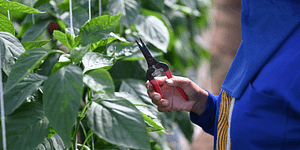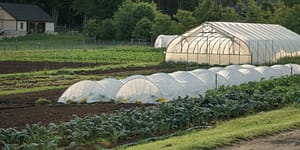Food Justice: What it Means and Why We Need it

What does true food justice look like? Elizabeth Henderson, longtime sustainable activist, Chelsea Green author (Sharing the Harvest), Farmer at Peacework Organic Farm, and co-Founder of the Agriculture Justice Project explores and explains what food justice means.
I come to my understanding of Food Justice from the perspective of my life as an organic farmer since 1980. Access for inner city and low-income people to healthy, clean, nutritious food is what you hear about most in news about food justice. According to USDA Economic Research Service in its annual report for 2012 on food security – nationally 48.9 million people live in households that are food insecure. In NYS 13.2% of all households are food insecure and 5% suffered “very low food security,” with more severe problems, deeper hunger, cutting back and skipping meals on a regular basis for both adults and children. 21.6% of all children live in food insecure households. Despite these distressing statistics, both houses of Congress agreed to cut the funding for nutrition programs in the Farm Bill of 2014.
Three Aspects of Food Justice:
- Access to healthy, locally grow, fresh, culturally appropriate food
- Living wage jobs for all food system workers – farmers, farmworkers, restaurant, food service, processing plant. . .
- Community Control through cooperatives, faith-based initiatives, community organizations
In Central/Western NY, where we have rich soils and many extremely productive farms as well as gardens, there is no shortage of food. Hunger comes from poverty.
Every bit as crucial as food access is just treatment and living wages for the people who grow, wash, cook, transport and sell our food. Over 17% of the jobs in this country are food related. If everyone who touched food (including both farm workers and farmers) made enough money to pay for high quality food out of their wages, our food system would be on its way to greater fairness and long-term economic viability.
Our society as a whole looks down on jobs that get people dirty.
Vocational studies are for youngsters who do poorly at academic courses. We call picking vegetables “stoop labor,” and the majority of the people who do this work are undocumented migrant farm workers whose average annual wages amount to less than $13,000 a year, according to the United Farm Workers. NYS law requires farmers to pay hired workers minimum wage, soon to rise to $9.00 an hour, and federal law requires paying legal H2A “guest workers” $9.60 an hour, but there is no requirement for time and a half for work over 40 hours a week, and even if you work 60 hours a week year round, minimum wage is poverty pay.
And there is no protection for farm workers who want to organize.
The National Labor Relations Act excludes two groups of workers – farm workers and domestics. Farm workers are not covered by the limited protections afforded to other workers by the National Labor Relations Act, particularly the right to form unions that is so much under attack these days. And protections for farmers in negotiating contracts with buyers are lacking too. The reality is that both family-scale farmers as well as farm workers in this country are in desperate need of fair trade.
My work as a farmer has largely focused on developing the Community Supported Agriculture (CSA) model as a way to ensure a decent living for family-scale farmers based on a fair contract with the people who join the CSA and agree to share the risks with the farmers. We started Peacework, the first CSA in western NY, during the winter of 1988-89. This season is our 26th. My involvement led to writing Sharing the Harvest: A Citizen’s Guide to Community Supported Agriculture (Chelsea Green, 2007) which tells our story based on interviews with hundreds of CSA farmers and organizers.
 Members and farmers harvest greens together early in the season at Peacework Farm. |
 An aerial view of Peacework Farm, Welcher Road, Newark, New York |
What the CSA model offers is a steady source of revenue and the chance to negotiate with your customers (buyers) to get a fair deal – pricing that covers the farmer’s full costs and pays the farmer a wage and even benefits such as health coverage or a pension fund. That is not profit – but it is a lot better than most ag deals or we would not have lost 4 1/2 million farms since I was born.
Carlos Petrini, founder of Slow Food, points out that farmers and their customers share a common fate. Petrini calls for food that is “good, clean and fair” and urges consumers to become “co-producers” with their farmers. Direct sales through farmers markets, on farm markets but especially CSA gives us the opportunity to transform the relationship between farmers and consumers. By sharing the risks of farming, consumers become co-producers in Petrini’s sense.
But what about food that you purchase in a store, restaurant or food service?How can you influence fairness in mainstream markets?
I have been representing the Northeast Organic Farming Association (NOFA) in an effort to answer this question by creating a social justice labeling program: Food Justice Certification. A sprinkling of farms and businesses has already been certified in Canada, Oregon, the Upper Midwest and Florida. In January, Swanton Berry Farm and Pie Ranch became the first farms to be Food Justice Certified in California. And in April, the Agricultural Justice Project (AJP) will announce the first three certifications in New York State – West Haven Farm, Green Star Coop and The Piggery Eatery and Butcher Shop, all in Ithaca.
AJP is a program jointly sponsored by four not-for-profits that work on behalf of farmers and farm workers. Since 1999, NOFA, CATA (the Farmworker Support Committee, Comite de apoyo a los trabajadores agricolas), Florida Organic Growers and Consumers (FOG) and Rural Advancement Foundation International (RAFI-USA), have been engaged in a stakeholder process to write standards for fairness in the food system.
The program is designed for all agricultural production systems, fiber, and cosmetics, as well as food. Candidates must meet high bar standards that have been negotiated among food system stakeholders including both farmers and farm workers.
The standards (which can apply to farms, buyers, distributors, processors and retailers—every link in the supply chain from farm to table) include:
- Fair pricing for farmers
- Fair wages and treatment of workers
- Safe working conditions
- Fair and equitable contracts for farmers and buyers
- Workers’ and farmers’ right to freedom of association and collective bargaining
- Clear conflict resolution policies for all throughout the food chain
- Clean and safe farmworker housing
- Learning contracts for Interns and apprentices
- A ban on full-time child labor together with full protection for children on farms
- Environmental stewardship through organic certification
The goal is to change relationships so that everyone benefits. More information, including contact information, is available at: www.agriculturaljusticeproject.org
By purchasing food with this label, consumers will ensure that farmers receive a fair percentage of the “food dollar”, allowing for a stable and dignified life for the farm family. Farmworkers will receive a living wage, and be able to adequately provide for themselves and their families. And the broader community will develop a bond with those who work the land, support the economic well-being of farmers and farmworkers, and gain access to food produced in accordance with their principles and ethics.
Such a model would be one concrete step in progressing toward a more sustainable food system, in which, as stated in the principles of the International Federation of Organic Agricultural Movements, the “entire production, processing and distribution chain [would be] both socially just and ecologically responsible.” In this alternate vision, farm work would be valued by the larger society in direct proportion to the importance of food in peoples’ lives, thereby allowing family farmers to remain on the land, and farmworkers and their families to live a full and healthy life.
If we are to have a local food system that reliably provides most of the food needs for the population of our region, we must shift our spending priorities. The people who grow our food, farmers and farm workers, must get a fair share so that they can go on producing and lead decent lives. They do not need or even want to live like corporate CEOs. Many of the organic farmers and homesteaders I know would be happy to serve as models for a living economy based on the principle of ENOUGH. The Nearings, Helen and Scott, projected an ideal of four hours a day for bread labor, four hours for creative and artistic activities and four hours for conviviality.
Because of economic pressures, these days, people trying to make a living farming are so far from that ideal it is not funny. But if we at least begin demanding that farmers and farm workers should make a living wage with full benefits, (health care, compensation for injuries and unemployment, and retirement) from a 40 hour week, we may start moving towards true food justice that will sustain us into a future worth living.
Recommended Reads
Agroforestry Versus Permaculture: Which Approach to Use for a Community Food Forest
Recent Articles
Pruning is essential for keeping protected crops healthy & balanced through the winter months. Keep reading for some helpful tips on pruning greenhouse and hoophouse plants! The following is an excerpt from The Greenhouse and Hoophouse Grower’s Handbook by Andrew Mefferd. It has been adapted for the web. Unless otherwise noted, all photographs copyright © 2017…
Read MoreStoring seeds is the key to having a successful growing season. Follow these tips for keeping seeds organized so you’re ready to plant as soon as the time is right!
Read MoreEver wonder what worms and centipedes are doing as they crawl through your soil? They’re actually working to improve the soil’s health, which benefits the environment and all living things in the long run. The following is an excerpt from Farming on the Wild Side by Nancy J. Hayden and John P. Hayden. It has been adapted…
Read MoreLearn how to grow shiitake mushrooms in almost any environment, including your yard and even your garage!
Read MoreWinter may be coming, but that doesn’t mean you should put away those tools just yet! Extend the growing season past the first frost with a few modifications.
Read More










